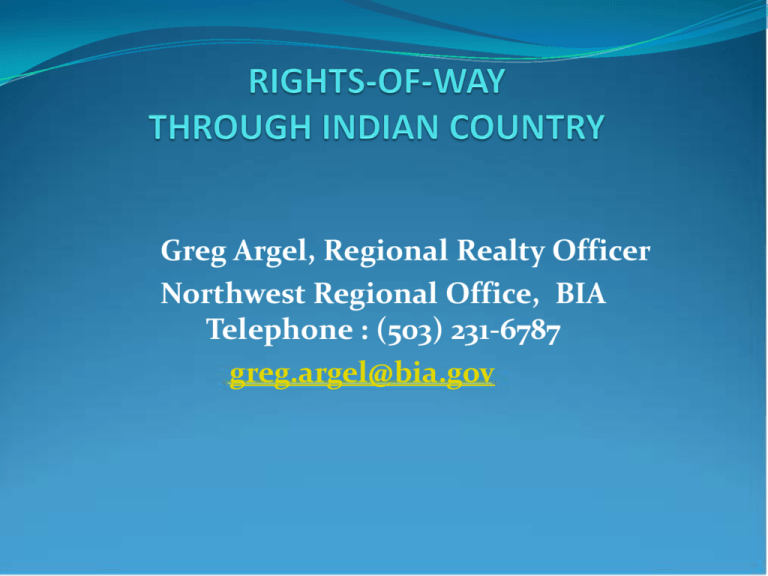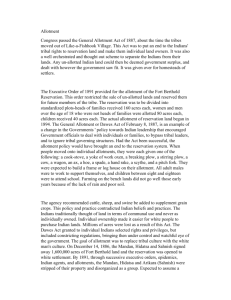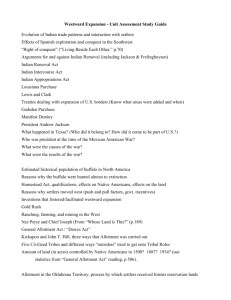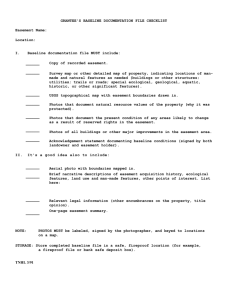Rights-Of-Way through Indian Country
advertisement

Greg Argel, Regional Realty Officer Northwest Regional Office, BIA Telephone : (503) 231-6787 greg.argel@bia.gov Trust Lands Location Acreages Tribes BIA Organization Northwest Region Bureau of Indian Affairs Total Acreages Northwest Region Tribal Trust Individual Trust Government 4,287,421.41 Acres 2,536,486.75 Acres 45,816.19 Acres Total: 6,869,724.34 Acres Land and Interests in Land 1. Fee Simple Absolute 2. Tribal Trust Lands 3. Allotted Lands a) Individual Trust Land Patent b) Restricted Fee Patent Tribal Trust Lands Reservations established under Treaty: by a provision of the Treaty the Tribe cedes territory to the United States; another provision reserves land for the use and benefit of the Tribe, for examples, the Coeur d’Alene Tribe and the Makah Tribe Reservations established by Executive Order: Examples: Spokane Reservation and Shoalwater Reservation Lands Outside the Boundaries of a Reservation taken into trust by the U.S. under general authority of the Secretary (Section 5 of the Indian Reorganization Act) or special congressional acts Definition Tribal Trust Land Tribal land in which title is in the U.S. in trust for a tribe. For the purpose of this discussion, an Indian tribe is group of Indians recognized by the Federal Government as a distinct entity to which Federal Indian laws are applicable. “Ownership” for our purposes means all of the attributes of property ownership, or an equitable interest in land with the title being held by the Government as trustee. The members of a tribe do not have individual ownership interests in tribal land. Rather, their interests resemble those a stockholder has in the assets of a corporation. Definition Allotted Lands Allotted lands are those which have been removed from tribal ownership (generally) and given to individual members of the tribe. The tribe loses all property interests in the land which becomes the private property of the allottee. As early as 1798, tribal lands were divided into small tracts and distributed to the tribe’s members. Until 1887 allotments were made under laws dealing with specific reservations. In that year, the General Allotment Act provided for the allotment of lands to individual Indians on Indian reservations and, in some situations, from the public lands of the United States (i.e., from the Public Domain). Usually, the allotment process consisted of the five following elements: Definition cont. 1) 2) The allotment of the tribe’s land to its members. The issuance of a patent to the allottee which provided that the land would be held in trust for him by the Government for a specified period of years (usually 25). In some cases, the allottee received a deed or patent which conveyed fee title but contained restrictions against alienation and encumbrance without the permission of the U.S. Government. 3) The land and the income from it could not be taxed by a state, sold, leased or otherwise contracted for by the allottee during the trust period, unless specifically authorized by the Congress. Definition cont. 4) The issuance of the fee or absolute title to the Indian owner or his heirs at the end of the trust period, or the removal of restrictions, as was appropriate. After receiving the fee title or removal of restrictions, the owner could sell, lease, or otherwise use the lands as he saw fit. The land was also subject to state taxes after the fee title was issued. 5) The granting of U.S. citizenship to the allottee. Although many Indians were made United States citizens under the allotment acts, it was not until,1924 that a general act was passed conferring citizenship on all Indians born within the territorial limits of the Untied States. The same act specified that Indians would also be citizens of the states in which they resided. Allotments continued: In 1884 the federal government established the Indian Homestead Act. The Act stated that if tribal members surrendered their tribal status and became U.S. citizens, they could receive a 160-acre homestead, provided that they settled on the homestead and improved the tract of land. Fortunately, “surrender of tribal status” as a condition was not rigorously required. Trust Patent for Allotment and Restricted Fee Patent Subject to Restrictions - Distinction Trust Patent for Allotment: “in trust for the sole use and benefit of the said Indian” Fee Patent Subject to Restrictions: “that the title hereby conveyed shall not be subject to alienation or encumbrance, either by voluntary conveyance or by judgment, decree, or order of any court, or subject to taxation of any character, but shall remain inalienable and not subject to taxation for the period of twenty years .” Allotments continued For most “realty transaction” purposes, (including the granting of easements) trust allotments and restricted fee allotments are treated the same. The main difference is in the method for conversion of the trust allotment to fee status and the “lifting of the restrictions” from a restricted fee allotment. Northwest Region Title Plant Fax (503) 231-6715 Agency Realty Records National Archives and Records Centers If Renewal, Applicant’s Records County Records Former Program: Land Record Information System (LRIS) Agencies are responsible for entering easements into TAAMS. EASEMENT An interest in land owned by another person, consisting in the right to use or control the land, or an area above or below it, for a specific, limited purpose. A Right-of-Way is a type of easement. AUTHORITIES FOR GRANTS OF EASEMENTS Act of March 3, 1901 (25 U.S.C. § 311) authorized the Secretary to grant rights-of-way to a State or local authority for the opening an establishment of public highways in accordance with State law through Indian reservations and allotted lands. Act of February 5, 1948 (25 U.S.C. § 323 et seq.) authorizes the Secretary to grant rights-of-way over tribal and allotted lands for all purposes; requires use of right-ofway be specifically identified in application. Requires consent of IRA Tribe (25 CFR Part 169 applies consent requirement to all tribes). Requires majority consent of allotment owners. DURATION Unlike a lease or license, an easement may last FOREVER, but it does not give the holder the right to possess, take from, improve, or sell the land. ROWs granted under part 169 shall be for a period not to exceed 50 years. 25 CFR sec. 169.18 ROWs longer than 50 years should be sent to the NWRO for review. TYPES OF EASEMENTS 1) RIGHT-OF-WAY: The right to pass through the property owned by another. 2) RIGHT TO LIGHT OR AIR. 3) RIGHT TO ACCESS WATER. 4) RIGHT TO KEEP SOMETHING ON THE SERVIENT ESTATE. (e.g., CONSERVATION EASEMENT FOR WILDLIFE HABITAT OR SIGNAGE) EASEMENT APPURTENANT An easement created to benefit another tract of land. Examples – Access road rights of ways (ROWs), Water line ROWs, sewer line ROWs, and electrical line ROWs. DOMINANT ESTATE The land benefiting from an easement. SERVIENT ESTATE The land burdened by an easement. PRESCRIPTIVE EASEMENT An easement created from an open, adverse, and continuous use over a statutory period. There are NO Prescriptive Easements on ANY Federal Property, including tribal or individual trust property. Implied Easements (A Theory) Applies to former allotments on a reservation Requires following factors: a) A fee parcel was formerly part of the reservation and was severed from Federal ownership by allotment process; b) No feasible, alternative route to the property that does not cross trust land; and c) The road was built prior to the 1948 enactment providing for the Secretary to grant rights-of-way across Indian land. SUBDIVIDING AN ALLOTMENT When an allotment is subdivided into separate tracts or lots, there MUST be access easements for all utilities (water, sewer, & electric) and ingress and egress for each new tract or lot. EASEMENT IN GROSS An easement benefiting a particular person or entity, but not a particular piece of land. Example – Bonneville Power Administration (BPA) transmission line, public highways, railroads, oil and gas pipelines. PROCEDURES How to Process a Request for Grant of Easement for Right-of-Way. APPLICATION REQUIREMENTS 1) Application for Grant of Easement for ROW (in DUPLICATE). 2) Consents of Landowners (ROW Form 94-7). 3) Map of definite location (2 original mylars & 2 copies, See 25 CFR 169.6,7,8,9,10 &11) CONTINUED APPLICATION REQUIREMENTS 4) Deposit of estimated damages or compensation (See 169.4 & 169.14) 5) Evidence of Authority of Officers to Execute Papers (ROW Form 94-4) 6) Permission to Survey for ROW. CONTINUED APPLICATION REQUIREMENTS 7) FOR CORPORATIONS: 169.4&5 a) State certified Articles of Incorporation. b) Certified Corporate Resolution, By-Laws, Articles of Partnership or Association authorizing signatory to file the application. TITLE STATUS REPORT Request a TSR from LTRO. Under ILCA sec. 2216(e) – Names, address, and ownership interest may be disclosed to prospective users for a specific tract. ID numbers and other “personal” information should be redacted. CONSENT FOR PERMISSION TO SURVEY 1) Application for Permission to Survey Should Include: a) Purpose b) General Location c) Written Consents for permission to survey required by 25 CFR sec. 169.3 CONSENT FOR INDIVIDUALS The Secretary may issue permission to survey and may grant ROW for individual owners when: 1) owners are minors or non compos mentis. 2) The majority ownership consents. 3) owners whereabouts are unknown. 4) heirs of an estate have not been determined. 5) owners are so numerous it would be impracticable to obtain their consent. MAPS/PLATS (IN DUPLICATE) 1) Width and Length of ROW should be clearly shown with center-line. 2) Scale should be 2,000 ft. to inch or larger. 3) Map should show allotment numbers, together with sections, townships, and ranges. AFFIDAVIT AND CERTIFICATE Maps require an affidavit executed by the engineer who made the survey and a certificate executed by the applicant, certifying to the accuracy of the survey. APPRAISAL REQUEST Submit request directly to the Regional Office of Appraisal Services with the following attachments: 1) TSR 2) Survey Plats & Maps 3) Partition Plan CONTINUED APPRAISAL REQUESTS 4) Letter of Intent 5) Letter of Consent 6) Copy of ROW Agreement or Application. 7) Proposed Leases & Permits & Water Rights (if any). CONSIDERATION FOR ROW Consideration shall not be less than fair market value (FMV), plus severance damages (if any). 25 CFR Section 169.12 Consideration can be more than FMV. 25 CFR Section 169.12 STATEMENT OF FAIR MARKET VALUE Trust land owners must be informed of the appraisal information prior to giving their consent for a ROW. Trust land owners may request Superintendent to negotiate consideration on their behalf. CONSENTS TO GRANTS OF ROW 1) Written Consent of Tribe for ROWs on Tribal Trust Land is required. 2) Written Consent of Individual Indian owners for ROWs on Individual Trust Land is required. See 25 CFR sec. 169.3 ILCA PERCENT REQUIREMENTS NOT APPLICABLE TO ROW’S Majority Requirement of 25 CFR Part 169 Regulation Supersedes the Percent Requirements of the Indian Land Consolidation Act. EMINENT DOMAIN The inherent power of a government to take privately owned property and convert it to public use, subject to reasonable compensation. CONDEMNATION The determination and declaration that certain property is assigned to public use, subject to reasonable compensation; the exercise of eminent domain. Condemnation is allowed against Individually-owned trust land, but condemnation is NOT allowed against Tribally owned trust land. Any attempt to take action to condemn individually-owned lands for a ROW must be reported immediately to the BIA office having administrative jurisdiction over the lands. 25 CFR sec. 169.21 NEPA NATIONAL ENVIRONMENTAL POLICY ACT of 1969 (NEPA). Section 102(2) of NEPA established procedures that are binding on all Federal agencies. The primary requirement is that an Environmental Impact Statement (EIS) be prepared for every major Federal action significantly affecting the quality of the human environment. Environmental Assessment ENVIRONMENTAL ASSESSMENT (EA) – An EA is a concise public document, for which a federal agency is responsible, that provides sufficient analysis for determining whether a proposed action may or will have a significant impact on the quality of the human environment. CATEGORICAL EXCLUSION CATEGORICAL EXCLUSIONS – Actions listed in 516 DM 2, Appendix 1 and 516 DM 10.5 have been determined not to individually or cumulatively affect the quality of the human environment. DAMAGE DEPOSIT Applicant must deposit into a “special deposit” account the total estimated consideration for the ROW, severance damages caused during the survey, and estimated damages to result from construction. 25 CFR sec. 169.14 Indemnification for Government Agencies may be waived if applicant agrees in writing to pay damages promptly when they are sustained. ARCHAEOLOGICAL CLEARANCE An Archaeological Clearance is required for Archaeological Sensitive Areas. The following clause should be in all ROWs: GRANTEE agrees that during the term of this Grant of Easement, if any previously unidentified cultural resources are discovered within the easement area, work should be halted immediately and the BIA and/or Tribal Contractor should be contacted immediately. PERMISSION TO CROSS AN EXISTING ROW Permission may be required if the proposed ROW crosses an existing ROW. For example: a railroad right of way ACTION ON APPLICATION A duplicate original copy of the conveyance instrument, permanent and reproducible maps, the application, with any other pertinent documents shall be transmitted to the Land Titles and Records Office for recordation. 25 CFR sec. 169.15 AFFIDAVIT OF COMPLETION An Affidavit of Completion, shall be promptly filed with the Secretary upon completion of the ROW, in duplicate, executed by the engineer and certified by the applicant. One copy shall be sent to the Land Titles and Records Office for recording. 25 CFR sec. 169.16 FINAL INSPECTION REPORT After receiving the Affidavit of Completion, the ROW must be inspected to determine whether there have been damages caused during the survey or during construction. Any part of the Damage Deposit not required to cover damages shall be refunded to the applicant. PROCEDURAL HANDBOOK The March 6, 2006, “Bureau of Indian Affairs, Procedural Handbook, Grants of Easement for Right-of-Way on Indian Lands” can be e-mailed to you upon request. E-mail to: greg.argel@bia.gov








